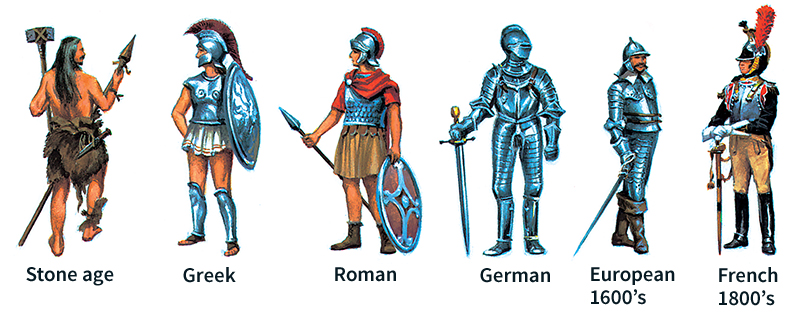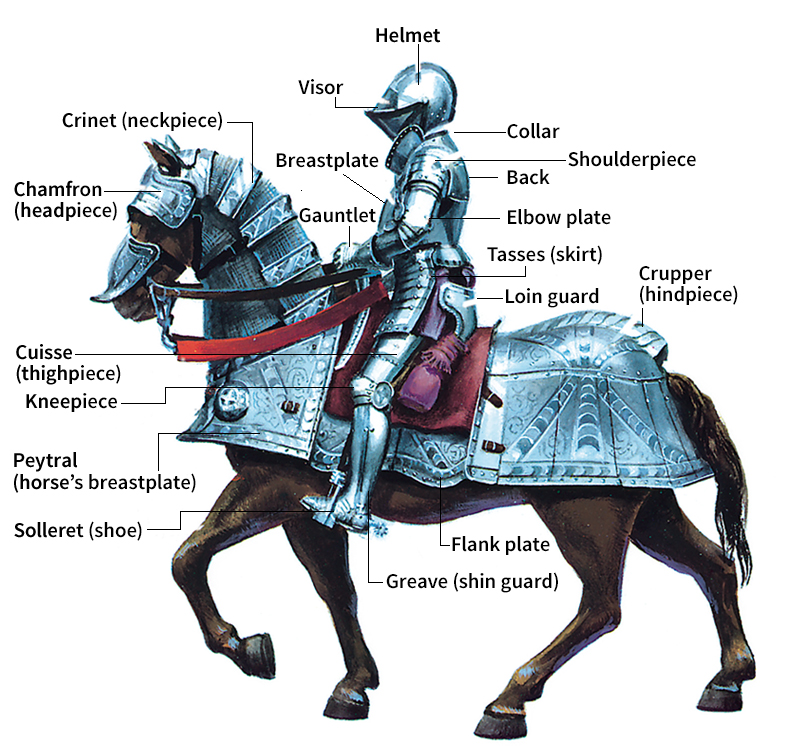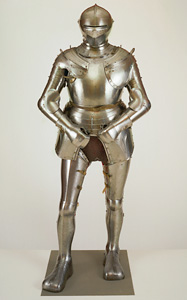Armor is a covering used primarily for protection in battle. Through the centuries, such materials as animal skins, bronze, and steel have been used to make armor. Until the invention of firearms, increasingly effective armor was designed to match advances in weapons. Today, armor is worn by members of the military and law enforcement. It is also used on ships, tanks, and other military vehicles.
In early times,
primitive people wore layers of animal hides to soften blows from clubs and axes. The Assyrians and people of other early civilizations carried shields and wore helmets and body armor made chiefly of leather strengthened with bronze. The Greeks and later the Romans wore helmets, cuirasses (short body armor), and greaves (leg armor), and they carried large shields. Greek and Roman armor was constructed mainly of bronze or steel, and it served as protection against arrows, spears, and swords.

During the Middle Ages,
the use of armor reached its peak. During the 1200’s, chain mail (tiny rings of metal linked together) served as the major form of protection. Suits of chain mail covered a knight’s body from head to foot and provided protection against arrows, lances, and swords. The crusaders and many other knights also wore metal helmets that covered the face.

By the 1300’s, foot soldiers fought with such weapons as crossbows, longbows, maces, and axes. Arrows fired from a longbow or crossbow could pierce chain mail, and blows from an axe or a mace would crush it. As a result, armorers (armor makers) began to produce plate armor consisting of large pieces of steel. By the 1400’s, suits of plate armor were designed to cover the entire body. Helmets, gauntlets (gloves), and shoes—all of steel—completed the outfit. Horses wore armor as well. Plate armor was highly effective, but it was extremely heavy and hot to wear. A suit of armor was also expensive, costing as much as a small farm.

Armorers were highly skilled craftsmen. Their job was to preserve lives, particularly those of leaders. After armor became a safe defense, armorers concentrated on decorating armor for tournaments and parades. Gothic armor produced in northern Italy and southern Germany became especially well known for its gracefulness and elegance. German Maximilian armor of the early 1500’s was fluted (grooved) to give it extra strength and a glancing surface. By the mid-1500’s, armor was etched or engraved with designs or scenes, and was often gilded or silvered. Later examples imitated current fashions in dress, or were exaggerated and grotesque.
Guns changed the ways of waging war and therefore the protection needed. Armor, made ever thicker and heavier to be bulletproof, became too heavy to wear. By the mid-1600’s, only helmets and breastplates continued to be used.
Later developments.
By the 1900’s, the only armor soldiers wore was a helmet. Engineers began to work on group protection, armoring trains, ships, and other vehicles. During World War I (1914-1918), the British developed the tank. The tank became one of the most important weapons in World War II (1939-1945) and later conflicts. During the Korean War (1950-1953) and the Vietnam War (1957-1975), soldiers wore bulletproof body armor made of light, strong synthetic material. Today, some body armor is lined with pockets holding ceramic plates that can break up bullets.
Besides its use in warfare, armor is also worn by some people in their jobs. For example, police officers sometimes wear bulletproof vests and helmets and carry riot shields. Helmets are part of hockey and football players’ uniforms.
See also Aramid ; Knights and knighthood (Armor) ; Gauntlet ; Helmet ; Shield .
